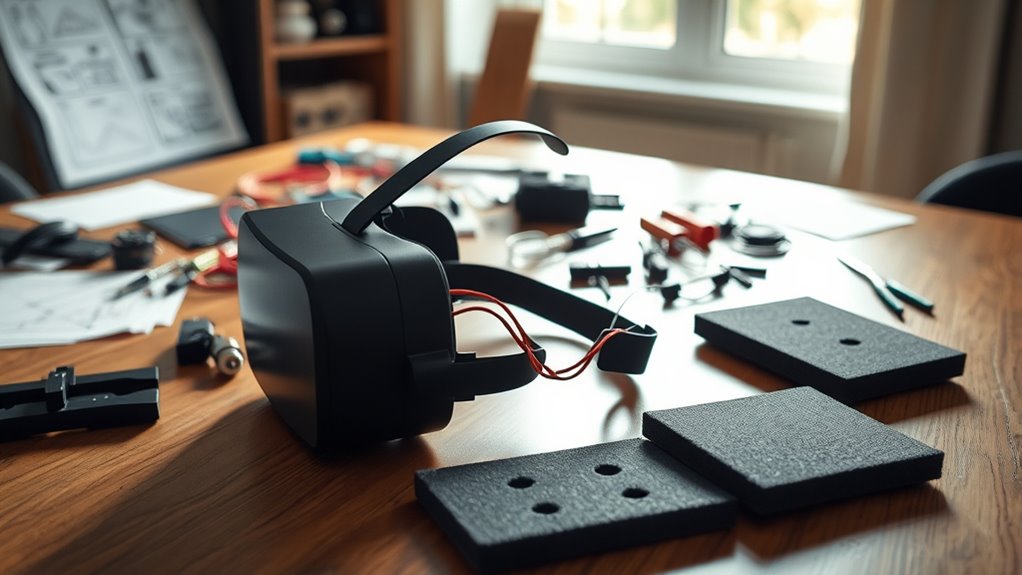To build your own VR headset, start by gathering materials like Fresnel lenses, high-density foam, and sturdy frame material such as cardboard. Cut the frame for a comfortable fit and attach adjustable straps for balance. Next, verify your smartphone’s settings are optimized by checking compatibility and adjusting display features. Enhance your experience by creating a quiet environment and exploring different apps. Stick around for further tips on troubleshooting common issues and maximizing immersion in your VR journey.
Materials Needed for Your DIY VR Headset
When you’re ready to plunge into building your own VR headset, gathering the right materials is essential for a successful project. Start with lens types—Fresnel lenses or aspheric lenses are popular choices for their clarity and wide field of view. Each type impacts your visual experience, so choose wisely. Next, consider foam padding; it’s vital for comfort during prolonged use. You’ll want a high-density foam that molds to your face, reducing pressure and enhancing immersion. Additionally, don’t forget the frame material; cardboard can work, but something sturdier might yield better results. By selecting these components carefully, you’ll set the foundation for a VR headset that not only performs well but also feels great to wear, giving you that ultimate freedom to explore virtual worlds.
Step-by-Step Assembly Process
Building your DIY VR headset can be broken down into several key steps to guarantee a smooth assembly process. First, start with lens selection; choose lenses that offer a focal length compatible with your smartphone’s display for ideal clarity. Next, carefully cut the headset’s frame from your chosen material, ensuring it comfortably fits your face. Once the frame’s ready, it’s time to focus on strap design. A well-designed strap enhances comfort and stability, so consider adjustable straps that distribute weight evenly. Attach the lenses securely within the frame, ensuring they’re aligned with your eyes. Finally, assemble everything together, double-checking for sturdiness. With these steps, you’ll have a functional VR headset that reflects your personal touch and creativity!
Setting Up Your Smartphone for VR
To get the most out of your DIY VR headset, setting up your smartphone properly is essential. First, you’ll want to verify your device has smartphone compatibility with VR apps. Here’s how to prepare:
Setting up your smartphone correctly is key to maximizing your DIY VR headset experience.
- Check your smartphone’s specifications: Confirm it meets the requirements for VR.
- Update your operating system: Having the latest software can enhance performance.
- Select the right apps: Choose VR apps that suit your interests and offer immersive experiences.
- Adjust settings: Tweak your display settings for brightness and resolution to optimize visuals.
Enhancing Your VR Experience
While setting up your DIY VR headset is a crucial first step, enhancing your overall experience is where the magic truly happens. To improve immersion, consider the environment around you. Use a quiet space, dim the lights, and minimize distractions. Adjusting visuals on your smartphone can greatly impact your experience; tweak brightness and contrast settings to find that sweet spot. Additionally, explore various VR apps and games that offer rich, interactive environments. Don’t hesitate to experiment with different lenses or head straps for comfort. Remember, the goal is to make your virtual journey as engaging as possible. By focusing on these elements, you’ll reveal the true potential of your DIY headset and enjoy an enthralling VR experience.
Troubleshooting Common Issues
When you’re immersed in the virtual world, encountering issues with your DIY VR headset can be frustrating. However, many problems can be easily resolved with a little troubleshooting. Here are some common issues you might face:
Encountering issues with your DIY VR headset can be frustrating, but many common problems are easily fixable with troubleshooting.
- Lens alignment: Verify the lenses are properly positioned for a clear view.
- Audio quality: Check the connections and settings to enhance sound clarity.
- Head strap comfort: Adjust or replace the strap to improve fit and comfort.
- Screen glare: Experiment with lighting and screen positioning to minimize reflections.
Frequently Asked Questions
Can I Use Any Smartphone for My DIY VR Headset?
Not every smartphone’s fit for your DIY VR headset. Think screen resolution and smartphone compatibility; they’re key. A high-res display immerses you deeper, while compatibility guarantees a seamless experience. Choose wisely, and let freedom guide you!
How Much Does It Cost to Build a DIY VR Headset?
Building a DIY VR headset can cost anywhere from $50 to $300, depending on your budget considerations and component selection. By choosing wisely, you can create an immersive experience without breaking the bank.
What Are the Best Apps for DIY VR Headsets?
For your DIY VR headset, explore apps like Oculus Venues for social interaction, Wander for virtual tours, and VR Fitness for tracking workouts. They’ll turn your device into a gateway for immersive experiences and creative tools.
Can I Use My VR Headset With a Gaming Console?
Yes, you can use your VR headset with a gaming console, but make sure it has console compatibility. This enhances your gaming experience, allowing you to plunge into immersive worlds and explore new dimensions of gameplay.
Is It Safe to Use a DIY VR Headset for Long Periods?
Isn’t it essential to guarantee your comfort levels? Using a DIY VR headset for long periods can lead to eye strain if it’s not properly designed. Make adjustments for comfort to enhance your experience and prevent discomfort.

